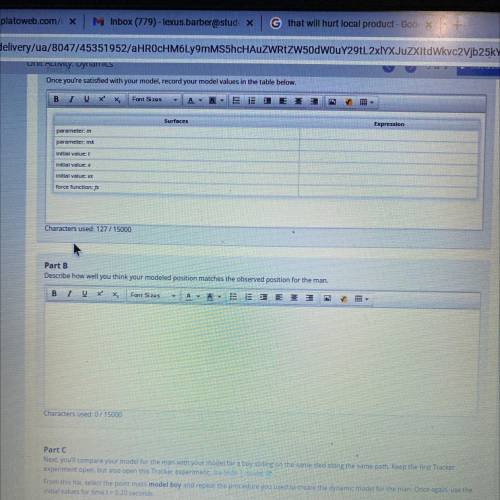
Physics, 27.10.2021 14:00 cameronbeaugh
Now that you know how forces affect the motions of objects, you can use the Tracker video analysis tool to create dynamic models
for a wide range of physical situations.
Tracker enables you to create two different types of mathematical models: analytical and dynamic. An analytical model enables you
to enter mathematical expressions for x and y positions as a function of time. That's sometimes useful, but from a physics
perspective, a dynamic model is much more flexible and powerful.
A dynamic model enables you to set the initial conditions for a particular system (Initial positions and velocities); then you can
mathematically define any forces acting on that system. Once those are set up, the model acts like an object in space, responding to
the forces you've imposed on it. It can continue moving forever, if that's what the forces would do to an object in real life. By visually
matching a marker for your model to the real motion on the video, you can define and refine a mathematical model for a wide range
of real-world situations.
In the first two tasks of this Unit Activity, you'll create dynamic models for motions in both one and two dimensions.
Activity Research - Creating a Dynamic Particle Model
Before you begin, do a little research and find out where you can get help in creating your models. In Tracker, you can always access
illustrated help to do anything. In Tracker, you can always access the illustrated Help dialog (? In the Toolbar).
For this project, you're going to need to check out the Tracker Help Instructions for Dynamic Models. You can print this Help
document, but it is available from Tracker anytime you need to refer to it.
For this project, you're going to need to check out the Tracker Help Instructions for creating a dynamic model.
Instructions - Building your Dynamic Model


Answers: 1


Another question on Physics

Physics, 22.06.2019 07:50
Determine the fraction of the magnitude of kinetic energy lost by a neutron (m1 = 1.01 u) when it collides head-on and elastically with a target particle at rest which is 21h (heavy hydrogen, m = 2.01 u).
Answers: 3

Physics, 22.06.2019 14:20
4r-134a enters the condenser of a residential heat pump at 800 kpa and 50°c at a rate of 0.022 kg/s and leaves at 750 kpa subcooled by 3°c. the refrigerant enters the compressor at 200 kpa superheated by 4°c determine (a) the isentropic efficiency of the compressor, (b) the rate of heat supplied to the heated room, and (c) the cop of the heat pump. also, determine (d) the cop and rate of heat supplied to the heated room if this heat pump operated on the ideal vapor-compression cycle between the pressure limits of 200 and 800 kpa. (0.757, 4.37 kw, 5.12, 6.18, 3.91 kw)
Answers: 3

Physics, 22.06.2019 16:00
An charge with mass m and charge q is emitted from the origin, (x,y)=(0,0). a large, flat screen is located at x=l. there is a target on the screen at y position y(h), where y(h) > 0. in this problem, you will examine two different ways that the charge might hit the target. ignore gravity in this problem. 1.assume that the charge is emitted with velocity v(0) in the positive x direction. between the origin and the screen, the charge travels through a constant electric field pointing in the positive y direction. what should the magnitude e of the electric field be if the charge is to hit the target on the screen? express your answer in terms of m, q, y(h), v(0), and l. 2.now assume that the charge is emitted with velocity v(0) in the positive y direction. between the origin and the screen, the charge travels through a constant electric field pointing in the positive x direction. what should the magnitude e of the electric field be if the charge is to hit the target on the screen? express your answer in terms of m, q, y(h), v(0), and l.
Answers: 1

Physics, 22.06.2019 18:00
Can you receive a shock severe enough to prevent you from releasing the wire from an ordinary outlet with dry hands? a. no b. yes explain
Answers: 1
You know the right answer?
Now that you know how forces affect the motions of objects, you can use the Tracker video analysis t...
Questions

Business, 09.11.2020 09:20

Biology, 09.11.2020 09:20


History, 09.11.2020 09:30


Chemistry, 09.11.2020 09:30

Arts, 09.11.2020 09:30



Mathematics, 09.11.2020 09:30


English, 09.11.2020 09:30

Geography, 09.11.2020 09:30

Spanish, 09.11.2020 09:30



Chemistry, 09.11.2020 09:30

Mathematics, 09.11.2020 09:30




